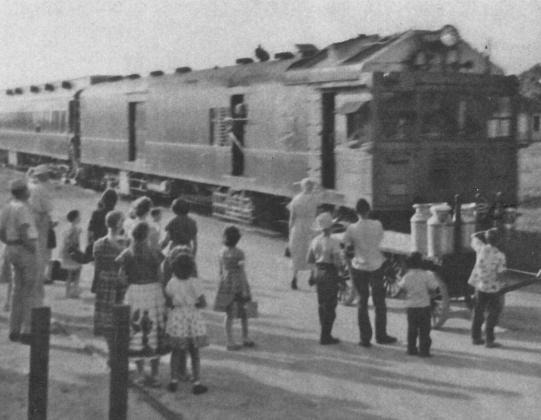As a light hearted name for a rail passenger car, people called it a Doodlebug. It was a rail car with a diesel motor in the front, room for baggage and mail in the middle and a passenger car in the back. Since it was just powered by diesel, it was much cheaper to operate then a full passenger train. As the number of rail passengers diminished, this type of rail transportation became more common. They enabled the railroads to continue passenger service when decreasing ridership offered limited funds to cover railroad expenses.
I recently talked with one Dubliner, who as a little girl rode the Doodlebug train. She said that there was a tank of drinking water in the passenger coach. It was so much fun to her filling up her cup that she ended up drinking a lot of water on that trip.
After World War II, everyone wanted a personal car to drive so this lead to the eventual end of rail passenger service on the MKT rails.
The Dublin Progress May 13, 1949 had an article saying the MKT was wanting to abandon passenger trains along the Waco to Stamford route. Dublin Postmaster Shillingburg said that it would not have a big impact on Dublin’s mail service.
In the August 26, 1949 Dublin Progress “Postmaster Tate Counts of De Leon testified that proposals for handling mail by truck and other routes would not be suitable if the passenger train is abandoned. Harold Riise secretary of the De Leon community club presented a resolution asking that towns along the Texas Central route be given “another six months or more” to build up revenue for the passenger mailexpress service.”
“The Doodlebug ran a 254 mile round trip daily between Waco and Stamford. People loved the moaning horn of the diesel motor car, but comparatively few of the residents have ever ridden on it.”
The Dublin Progress on September 23, 1949 stated that the state Railway Commission of Texas ordered that the Doodlebug keep running. Dublin’s Dick Harbin acted as special attorney representing all the towns along the way.
There were a number of meetings held for citizens to voice their opinion.
On June 3, 1950 the Doodlebug came to the end of the line. The money was no longer there to pay expenses for the rail service. Passenger trains from Waco to Stamford had begun on February 8, 1900 and continued for 50 years.
Engineer R. N. Hill manned the last run from Waco to De Leon then gave the controls to Fred Echols for the rest of the Stamford to Waco trip. Conductor Wilbur Wright gave over the train to Claude Webster to finish the final run. Webster of Waco had reached retirement age in December but delayed his retirement so he could finish the final run of the Doodlebug.
With the Doodlebug, De Leon enjoyed 3 outgoing and 4 incoming mail services. Discontinuing of the train reduced it to 2 incoming and 1 outgoing mail services. With that, they were not able to handle live and perishable shipments of valuables.
To make up for the discontinued mail service, the post office began a star route using either a truck or bus between Dublin and Meridian with mail coming on Santa Fe trains in Dublin.
Though the article in the June 9, 1950 Dublin Progress didn’t give details, sometimes a post office star route referred to a bus reconfigured to be a post office on wheels.
This type of post office on wheels was used in Dublin and will be the topic of another Museum Matters.

